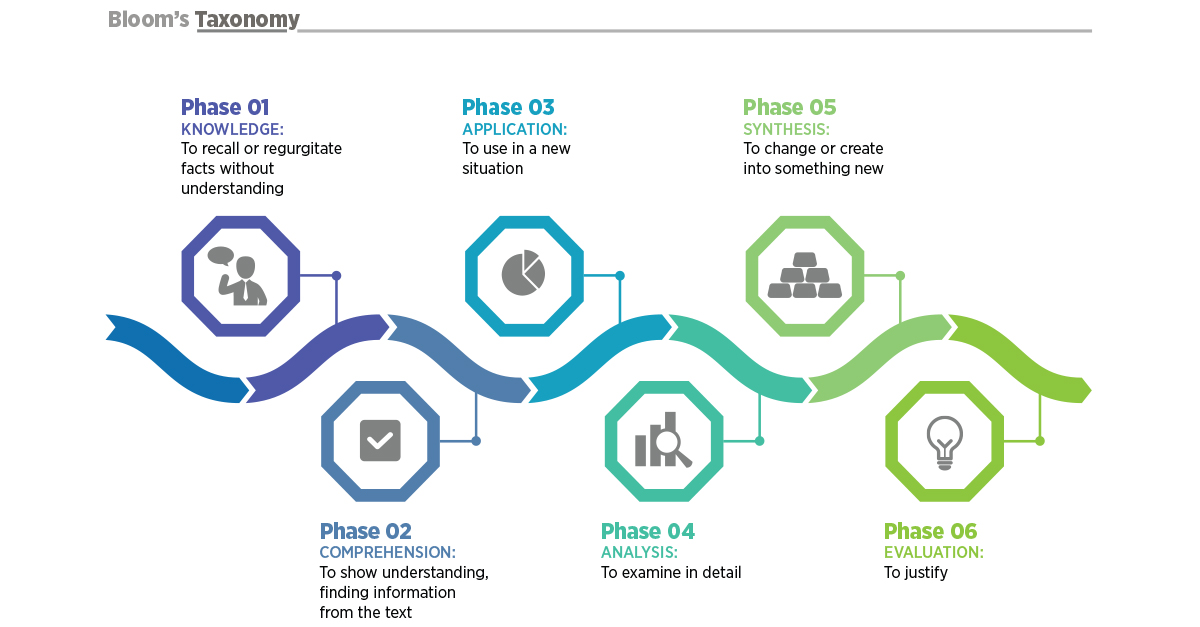- Knowledge – To recall or regurgitate facts without understanding. Exhibiting previously learned material by recalling facts, terms, basic concepts, and answers.
- Comprehension – To show understanding, finding information from the text. Demonstrating basic understanding of facts and ideas.
- Application – To use in a new situation. Solving problems by applying acquired knowledge, facts, techniques, and rules in a different way.
- Analysis – To examine in detail. Examining and breaking information into parts by identifying motives or causes; making inferences, and finding evidence to support generalizations.
- Synthesis – To change or create into something new. Compiling information in a different way by combining elements in a new pattern or proposing alternative solutions.
- Evaluation – To justify. Presenting and defending opinions by making judgments about information, validity of ideas, or quality of work based on a set of criteria.
If you ask trainers to describe their training objectives, they may use three words: learn, know, and understand. However, no training program is undertaken so a participant can learn, know, or understand something. Think about any training program you have been to recently. Why were you there?
Certainly you were there to obtain new knowledge, but was that really the end goal? What would the reaction have been if you walked back to your office after the training and did not do anything differently?
Put Knowledge to Use
The knowledge that you gain from training has no value if it is not used. Training allows you to accumulate knowledge and skills, but if it stops at the point you learn, know, or understand something and it never becomes an actionable output, then it is not effective training.
When you write learning objectives, use words describing what the learners will do with the knowledge they obtained. For example, an ineffective learning objective might read: “The learner will understand the process of presenting XYZ product.” Contrast that with an effective learning objective which might read: “The learner will show the process of presenting XYZ product.”
Consider using Bloom’s Taxonomy when creating learning objectives. Bloom’s Taxonomy was created in 1956 by Dr. Benjamin Bloom to help analyze and design training programs. It identifies six levels of learning:
Determine the Skill Level
The first step to creating an effective learning objective is to determine the level at which the learner needs to perform the skill. Knowledge and comprehension are viewed as lower-level thinking skills because we are not asking the learner to do anything with the information, just to demonstrate knowledge of it. The levels of application, analysis, synthesis, and evaluation represent high-level thinking skills since the learners have to apply the information to a situation they encounter.
Bloom’s Taxonomy recommends asking trainees pointed questions to gage their progress in the six levels of learning. For example, to determine their grasp of a new disinfection technique at the application learning level, ask learners to list the facility locations that would require this type of disinfection and any challenges they foresee in applying the disinfectant.
Create the Learning Objective
Use keywords to write a learning objective that is specific and centers on the action you want to see the learner demonstrate. Bloom’s Taxonomy suggests keywords that convey action, such as: calculate, demonstrate, organize, prioritize, and simplify. This process will enable you to evaluate your training by comparing the learner’s ability against a specific measurement.
A specific learning objective is like a compass because it guides the training and charts the course for the class. Structure the course so each learning objective has its own segment. A training class should have between 5 to 10 learning objectives.
Make sure your training objectives do not contain the word “and”—that usually indicates you have two learning objectives that you need to separate.




